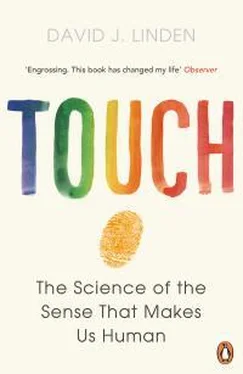When pain activates the spino-hypothalamic pathway, it produces a group of fight-or-flight responses, including increases in heart rate, sweating, breathing rate, core muscular contraction, etc. We can sense these responses both consciously and subconsciously, and they contribute to a sense of anxiety. When you are aware of your heart beating faster, you feel more uneasy and threatened. This is another positive feedback loop that can contribute to chronic pain: Subconscious fight-or-flight responses evoked by pain boost anxiety, which in turn increases pain.
The portion of the brain’s pain circuit including the insula, the anterior cingulate cortex, and the prefrontal cortex is crucially involved in comparing one’s expectations for pain with pain sensations as they are actually happening, and thereby generating predictions about the future. One key factor that is evaluated is threat, which originates externally. Pain that is self-generated is less threatening and is rated as both less intense and less unpleasant than pain that intrudes unexpectedly from the outside world. In the laboratory, self-generated pain is associated with reduced activation in both the primary somatosensory cortex and the anterior cingulate cortex when compared with the same pain stimulus generated externally. In one study this was demonstrated by having either the subjects themselves or the experimenter squeeze one hand with the other to produce compression force against pointed plastic beads. 27In other words, while it might hurt to accidentally hit your thumb with a hammer, at least you know how it happened, and you feel as if you can control the situation to reduce the chance of it happening in the future. That knowledge reduces the sense of threat and thereby attenuates the pain. Conversely, not knowing when a pain stimulus will occur again boosts both the intensity and the unpleasantness of the experience.

When patients are given a sugar pill or some other placebo and told that it will relieve pain, many will indeed experience a degree of pain relief (figure 6.7). While the prevalence and degree of the relief vary with the type of pain and the personality of the patient, on average, the placebo effect evokes significant analgesia in about 30 percent of patients. The underlying mechanism of the placebo effect is complex and probably involves both anxiety-reducing and unpleasantness-reducing components. Brain-imaging studies have shown that placebo analgesia is associated with the release of endorphins/enkephalins in several parts of the emotional pain circuit, including the anterior cingulate, prefrontal cortex, and amygdala, as well as the periaqueductal gray region. Naltrexone, a drug that blocks mu-opioid receptors, also blocks placebo analgesia, suggesting that the action of endorphins/enkephalins is required. 28A variant of the placebo effect can also be engaged to increase perceived pain: If patients are told that they are receiving an analgesic treatment that is unlikely to work, then fewer people will report pain relief, even if they are administered very effective analgesics like oxycodone or morphine. Or if people are given an inert control treatment but are told that it will increase pain, then, on average, subjects will report a heightened pain sensation. This is called the nocebo effect, and its biological basis is poorly understood, but it appears to be associated with increased activation of pain perception regions in both the spinal cord and the brain. 29

Figure 6.7John Haygarth was the first person to systematically investigate and report on the placebo effect. His book, published in 1800, examined the efficacy of “Perkins tractors,” a type of pointer touted as having the ability to draw out disease through their special metal tips. Haygarth showed that some people did improve after treatment with Perkins tractors, but they improved to the same degree when treated with fake Perkins tractors made of wood. His conclusion: Perkins tractors are a sham, but “the passions of the mind had a wonderful and powerful influence upon the state and disorder of the body.” If you think you’ll get better, then you are more likely to do so. The book’s epigraph, “Decipimur specie,” is an abbreviation of “Decipimur specie recti,” a well-known quotation by the Roman poet Horace, which translates as “We are deceived by the appearance of rectitude.” Used with permission of the Royal College of Physicians, Edinburgh.
Torturers are all too aware of the cognitive and emotional modulation of pain perception, which they exploit in horrifically dehumanizing ways to heighten pain and fear and leave their victims feeling powerless. Because they know that anticipation of pain can increase the experience of it enormously, they will often let their victims see and hear others being tortured to engage that anticipation and focus. Torturers likewise understand that the experience of pain is heightened by a sense of threat. This is accomplished by subjecting their victims to humiliation (stripping, sexual abuse, screaming) and to an irregular and unpredictable schedule of sleep/waking/feeding and torture.
Fortunately the same emotional and cognitive control circuitry that is exploited by torturers to maximize pain can potentially be used beneficially to reduce pain, particularly chronic pain. A number of mindfulness-based practices—including meditation, yoga, Tai Chi, and the Feldenkrais Method—have been reported to decrease both chronic and acute pain sensations. Although the quality of some of these studies has been low, lacking appropriate controls and enrolling too few subjects to allow for strong statistical analysis, there are indications from some large, randomized, well-conducted studies that these techniques can be efficacious for certain forms of chronic pain. 30
How might mindfulness-based training serve to attenuate pain? Let’s examine this in the context of meditation, for which there is useful literature examining pain perception and its neural processes. One general way to reduce pain would be to learn to exert some control over subconscious pain-evoked fight-or-flight responses, thereby attenuating pain-evoked anxiety and threat and reducing pain unpleasantness. 31This would interrupt one of the positive feedback loops that sustain chronic pain. Another way would be to learn to experientially open oneself to pain. Rather than avoid or reject the pain experience, one would learn over time that repeated pain is not a threat, and this nonreactive, nonjudgmental learning would then result in decreased pain unpleasantness. Indeed, recent studies from the group of Richard Davidson at the University of Wisconsin, Madison, have shown that expert Buddhist meditators (more than ten thousand hours of practice) engaging in open presence meditation report equal pain intensity but reduced pain unpleasantness in response to a heating laser when compared with novices. When brain scanning was performed, it revealed that expert meditators had reduced baseline activity but increased initial pain-evoked activity in the insula and the anterior cingulate cortex, which was attenuated with repeated stimulation. The authors suggest that meditative training to develop experiential openness decreases the anticipation of pain and increases the recruitment of useful attentional resources during pain to allow for effective learning. This learning would reduce the perception of threat, the related anxiety, and the concomitant fight-or-flight responses. 32
Zen is a different form of meditation. Rather than opening oneself to experience, one seeks a more detached form of self-regulation. The goal is not learning but to dissociate oneself by reducing higher-order evaluative processes. When Pierre Rainville’s group at the University of Montreal studied experienced Zen meditators with a thermal pain stimulus, they found a result that was similar to that of the Davidson group: Experienced meditators reported reduced pain unpleasantness and increased pain-evoked activity in the insula and anterior cingulate cortex as compared with nonmeditators. Crucially, they also showed reduced activity in the prefrontal cortex, an effect that was strongest in those Zen meditators who had the lowest pain unpleasantness scores. One interpretation of these imaging results is that the Zen meditators are not learning to conceptualize repeated pain as a nonthreat (which would presumably require the involvement of the prefrontal cortex) so much as they are simply deciding to ignore it. 33It is likely that there are multiple cognitive/emotional strategies that can serve to reduce pain.
Читать дальше














